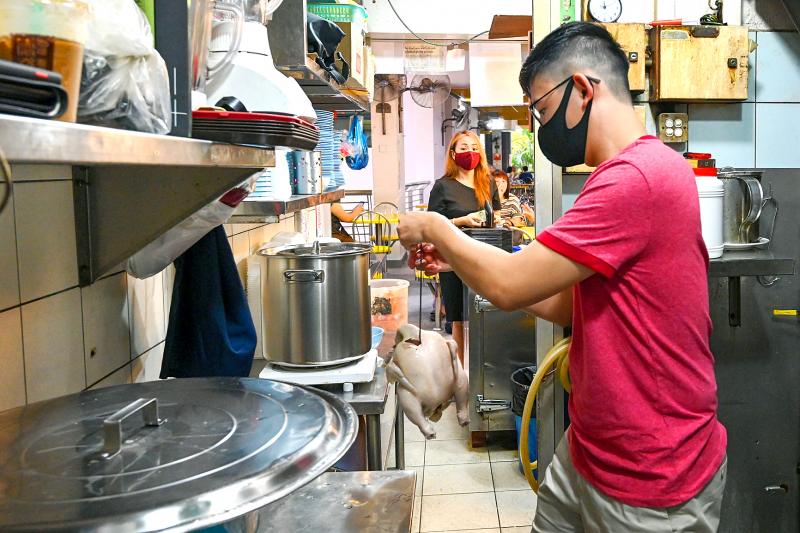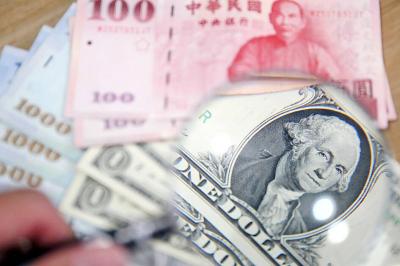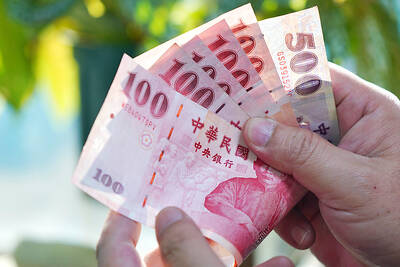After the pandemic torpedoed his chance to work at a Michelin-starred New York restaurant, Lim Wei Keat returned to his roots by becoming a Singapore street-food chef cooking local fare.
The 25-year-old is among a growing number of young street-food vendors — known as “hawkers” locally — fueling hopes that a new generation will preserve the city-state’s culinary traditions.
Singapore is full of open-air food courts offering a wide variety of cuisines influenced by the Southeast Asian nation’s ethnic Chinese, Indian and Muslim populations.

Photo: AFP
Even after the city-state ballooned into an affluent financial hub, the hawker tradition lived on, and remains a central part of everyday life for many.
The UN recognized this tradition as “intangible cultural heritage” in December, describing the centers where hawkers toil as “community dining rooms” that bring together people from diverse backgrounds.
However, many chefs are heading toward retirement — their median age is 59 — and young Singaporeans often shun the trade, stoking fears that hawker traditions and their delicious dishes could be lost.
Lim stumbled into becoming an apprentice hawker, only choosing to do so as he could not take up an internship at a US restaurant last year due to coronavirus travel curbs, but he feels he has found his true calling.
“Local dishes would disappear if young people did not take over stalls or learn [to cook] these dishes,” Lim said.
He got the apprenticeship through government initiatives aimed at safeguarding the street food culture, which has helped dozens of younger chefs join the trade.
Hawkers usually focus on just one or two dishes, from fried rice noodles and turnip cake to curry puffs. Lim chose an ever-popular traditional favorite — Hainanese chicken rice — and likes to cook it the old-fashioned way. “I love chicken rice, so why not start with something that I love and I’m passionate about?”
His mentor, 61-year-old Neo Cheng Leong, has been selling the dish for 30 years.
He makes it from scratch every morning at his stall, cleaning the chicken, poaching it at just the right temperature, then cooking the rice in chicken broth, with ginger and scallion-infused oil.
Cuts of the tender meat are served with a plate of the resultant fragrant rice with garlic chili sauce and sweetened soy sauce, all for just S$3 (US$2.30).
His two sons, both in their early 20s, are studying at university and have no interest in taking over the stall after seeing how hard their parents worked for three decades, Neo said.
“If I don’t teach [apprentices] then this flavor will disappear from Singapore,” Neo said.
Once Lim has completed his government training program — which includes two months of training under Neo, and cooking for a panel of judges — he can rent a stall at a heavily subsidized rate for 15 months.
Still, there are many challenges that make it hard to lure young Singaporeans from better-paid office jobs, such as rising costs and long hours.
And then there is the stigma.
“Back in the day, it was really seen as a profession for those who have no route into life,” said K.F. Seetoh, an influential critic and entrepreneur who created a popular guide for hawker food. “There’s still a school of people who would say ‘what, you want to be a hawker? What’s wrong with you?’”
Hawkers are also forced to keep prices low to compete with rivals, meaning that making ends meet in one of the world’s most expensive cities can be tough.
Shawn Aw, a chef who runs a noodle stall with his 60-year-old mother, admitted it was hard work and said he only made around S$1,000 per month — far below Singapore’s median wage, S$4,500, according to official data.
“You definitely have to come in early and go home late... it’s a bit tough, you have to work hard,” the 32-year-old said.

The US dollar was trading at NT$29.7 at 10am today on the Taipei Foreign Exchange, as the New Taiwan dollar gained NT$1.364 from the previous close last week. The NT dollar continued to rise today, after surging 3.07 percent on Friday. After opening at NT$30.91, the NT dollar gained more than NT$1 in just 15 minutes, briefly passing the NT$30 mark. Before the US Department of the Treasury's semi-annual currency report came out, expectations that the NT dollar would keep rising were already building. The NT dollar on Friday closed at NT$31.064, up by NT$0.953 — a 3.07 percent single-day gain. Today,

‘SHORT TERM’: The local currency would likely remain strong in the near term, driven by anticipated US trade pressure, capital inflows and expectations of a US Fed rate cut The US dollar is expected to fall below NT$30 in the near term, as traders anticipate increased pressure from Washington for Taiwan to allow the New Taiwan dollar to appreciate, Cathay United Bank (國泰世華銀行) chief economist Lin Chi-chao (林啟超) said. Following a sharp drop in the greenback against the NT dollar on Friday, Lin told the Central News Agency that the local currency is likely to remain strong in the short term, driven in part by market psychology surrounding anticipated US policy pressure. On Friday, the US dollar fell NT$0.953, or 3.07 percent, closing at NT$31.064 — its lowest level since Jan.

The New Taiwan dollar and Taiwanese stocks surged on signs that trade tensions between the world’s top two economies might start easing and as US tech earnings boosted the outlook of the nation’s semiconductor exports. The NT dollar strengthened as much as 3.8 percent versus the US dollar to 30.815, the biggest intraday gain since January 2011, closing at NT$31.064. The benchmark TAIEX jumped 2.73 percent to outperform the region’s equity gauges. Outlook for global trade improved after China said it is assessing possible trade talks with the US, providing a boost for the nation’s currency and shares. As the NT dollar

The Financial Supervisory Commission (FSC) yesterday met with some of the nation’s largest insurance companies as a skyrocketing New Taiwan dollar piles pressure on their hundreds of billions of dollars in US bond investments. The commission has asked some life insurance firms, among the biggest Asian holders of US debt, to discuss how the rapidly strengthening NT dollar has impacted their operations, people familiar with the matter said. The meeting took place as the NT dollar jumped as much as 5 percent yesterday, its biggest intraday gain in more than three decades. The local currency surged as exporters rushed to